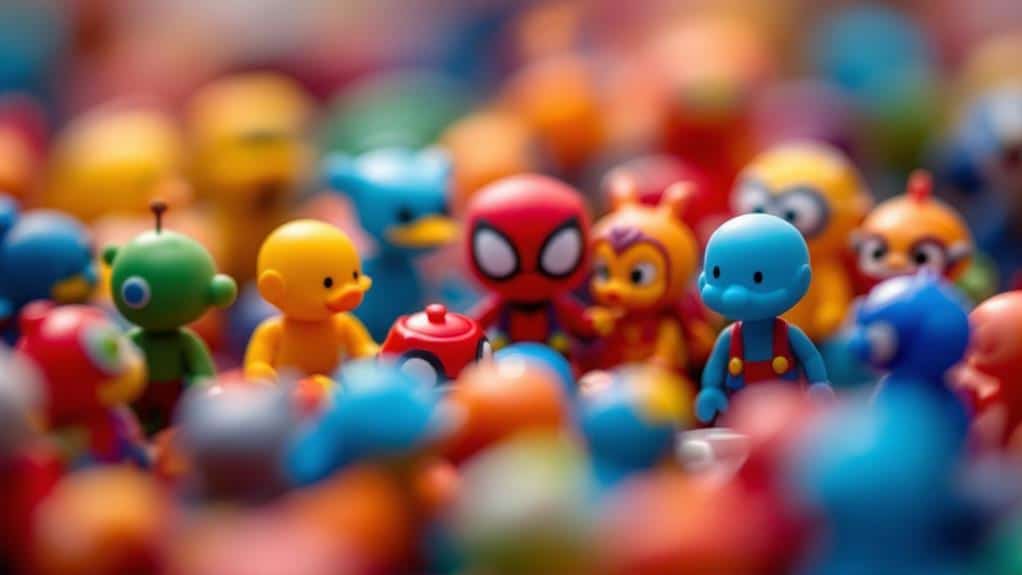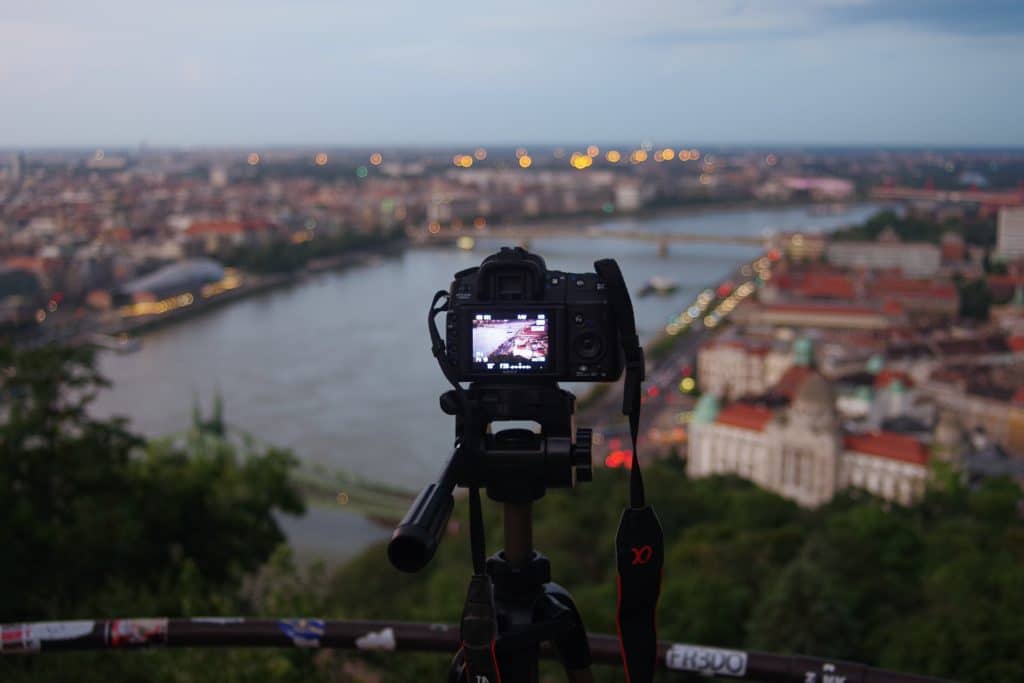If you're a toy collector looking to capture every intricate detail, consider these three affordable macro lenses. The Panasonic LUMIX G Macro Lens 30mm F2.8 offers a 1.0x magnification and a MEGA Optical Image Stabilizer for sharp, handheld shots. The Opteka Achromatic 10x Macro Lens is versatile, fitting 52mm and 55mm Nikon DSLR threads, providing exceptional image clarity at an affordable price. For the adventurous, the Super Macro Close-Up Lens for Micro Series & RM-4K focuses as close as 3.5 inches, making it perfect for detailed, up-close shots. These options can enhance your photography journey.
Key Takeaways
- Panasonic LUMIX G Macro Lens 30mm F2.8 offers high sharpness and smooth bokeh for detailed toy photography.
- Opteka Achromatic 10x Macro Lens is an affordable choice, providing exceptional image clarity for beginners.
- Super Macro Close-Up Lens excels in versatility and is designed for both underwater and dry conditions.
- Consider lens compatibility and magnification power for capturing intricate toy details effectively.
- Evaluate image quality, durability, and user reviews to identify budget-friendly, high-performing macro lenses.
Panasonic LUMIX G Macro Lens 30mm F2.8 (H-HS030)
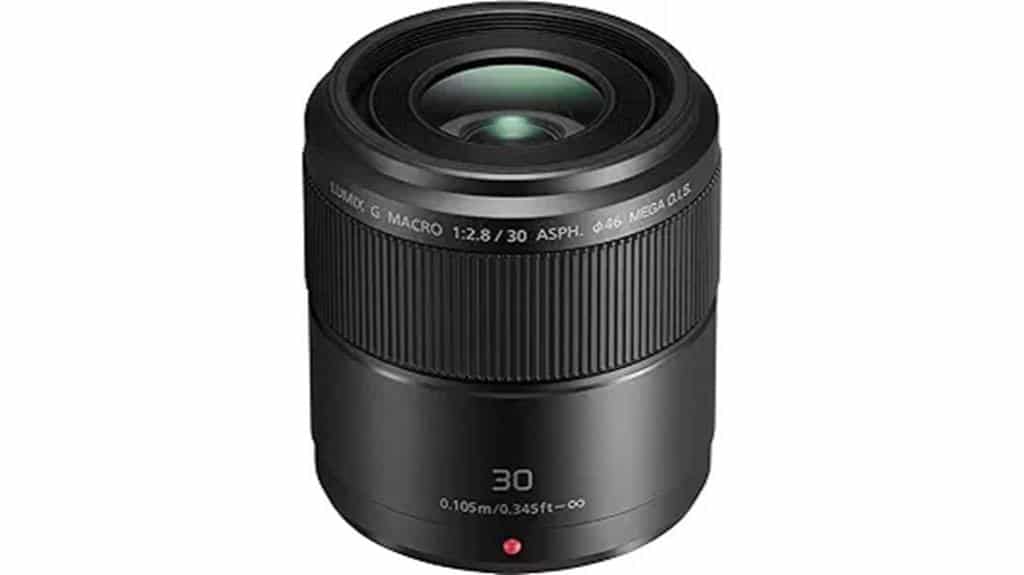
If you're a toy collector looking to capture the intricate details of your collection, the Panasonic LUMIX G Macro Lens 30mm F2.8 is an excellent choice. It offers approximately 1.0x magnification, allowing you to highlight every fine feature of your collectibles. You'll appreciate its high sharpness and contrast, which make it perfect for macro photography. The lens's beautiful bokeh expression guarantees your backgrounds are smooth, enhancing your subject's prominence. With MEGA Optical Image Stabilizer, you can shoot handheld without worrying about camera shake. While autofocus may falter with busy backgrounds, manual focus excels in precision. Constructed with a premium metal barrel, it's both light and durable. Although it lacks a lens hood, its versatility in macro and landscape photography makes it ideal for hobbyists.
Best For: Toy collectors and hobbyists looking to capture intricate details and beautiful macro shots of small objects with high sharpness and bokeh quality.
Pros:
- High sharpness and contrast, ideal for macro photography.
- MEGA Optical Image Stabilizer for handheld shooting.
- Premium build quality with a light and durable metal barrel.
Cons:
- Autofocus struggles with small objects against busy backgrounds.
- Fixed focal length not ideal for distant subjects.
- No lens hood included, which may be beneficial for general use.
Opteka Achromatic 10x Macro Lens for Nikon DSLR Cameras (Fits 52mm and 55mm Threads)
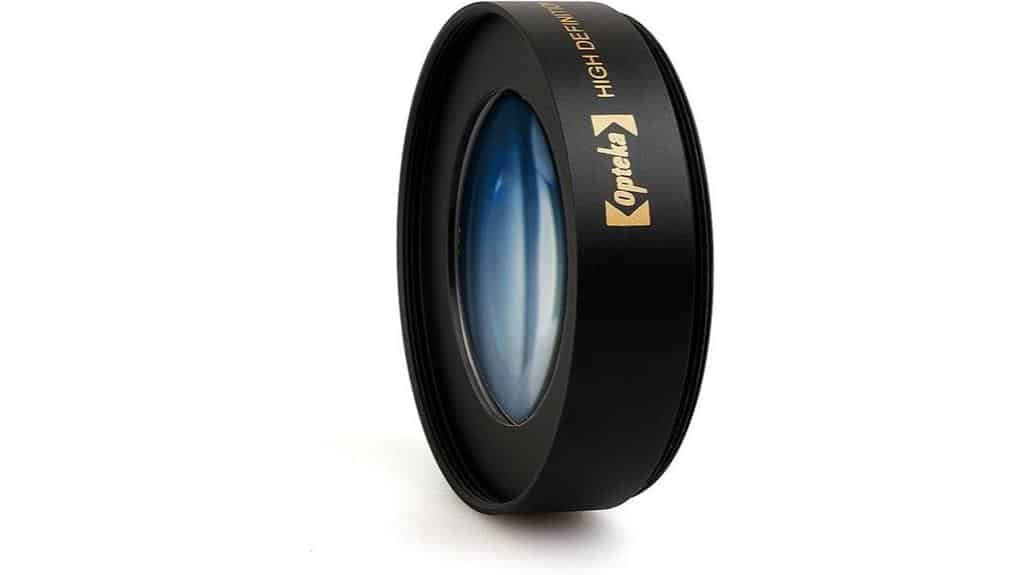
For toy collectors looking to capture the intricate details of their cherished miniatures, the Opteka Achromatic 10x Macro Lens offers an affordable and high-quality solution. This lens, compatible with a range of Nikon DSLR models, fits 52mm and 55mm threads, making it versatile for many setups. Its 10x diopter magnification and 4-element optical glass construction guarantee exceptional image clarity, minimizing flare with its anti-reflective coating. Despite its lightweight design, it boasts sturdy metal construction for durability.
While it's not a dedicated macro lens, it's perfect for beginners wanting to explore macro photography. Users praise its image quality but note the limited autofocus and low depth of field. Keep in mind lighting and focusing techniques to maximize your results.
Best For: Toy collectors and beginners in macro photography looking for an affordable and high-quality lens to capture intricate details. This lens is particularly well-suited for those who enjoy photographing small-scale subjects like action figures, model kits, or miniature collectibles. Regarded as one of the best macro lenses for figurines, it offers sharp image quality and excellent close-focusing capabilities, allowing you to capture every fine detail with precision. Its lightweight design and budget-friendly price make it a great starting point for hobbyists and professionals alike.
Pros:
- Affordable price with excellent image quality.
- Sturdy and durable metal construction.
- Versatile compatibility with Nikon DSLR models.
Cons:
- Limited autofocus capabilities.
- Low depth of field may require careful focusing.
- Potential vignetting at wide angles.
Super Macro Close-Up Lens for Micro Series & RM-4K
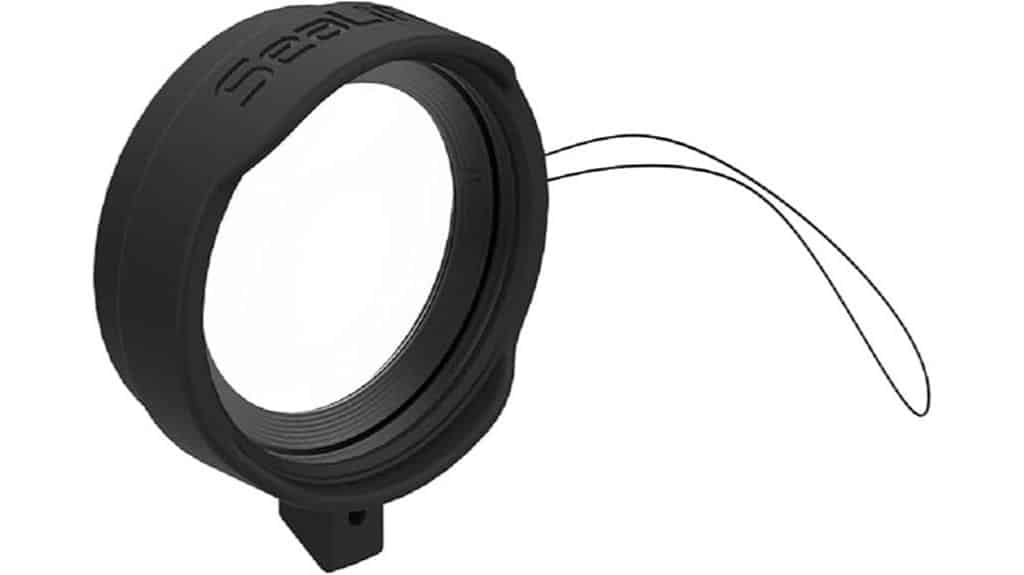
Toy collectors seeking to capture every tiny detail of their beloved miniatures will find the Super Macro Close-Up Lens for Micro Series & RM-4K cameras a game-changer. Designed for SeaLife cameras, this lens lets you focus as close as 3.5 to 7 inches, revealing intricate details you might miss otherwise. With its 2-element optical glass and anti-reflective coating, you'll capture sharp and vivid images. Though it's primarily for underwater use, it can handle dry conditions too, offering flexibility.
Expect ease of use and impressive close-ups, thanks to the included focus distance sticks. However, keep in mind some users noted missing accessories. While it holds a 3.4-star rating, its ability to enhance your toy photography is undeniable. Immerse yourself in a world of detail with this versatile tool.
Best For: Toy collectors and underwater photographers seeking to capture intricate details and vibrant close-up images.
Pros:
- Enhances clarity and precision for close-up photography.
- Constructed with high-quality optical glass and anti-reflective coating for sharp images.
- Includes focus distance sticks and safety lanyard for ease of use.
Cons:
- Some users reported missing accessories upon purchase.
- Average rating of 3.4 stars suggests mixed user satisfaction.
- Limited image improvement when used out of water.
Factors to Consider When Choosing 3 Affordable Macro Lenses for Toy Collectors
When you're choosing affordable macro lenses for your toy collection, start by verifying the lens is compatible with your camera. Consider the magnification power you need to capture those intricate details, and don't forget to assess autofocus capabilities for ease of use. Prioritize image quality, and look at the build material to guarantee durability and longevity in your lens investment.
Lens Compatibility Check
Verifying lens compatibility with your camera is vital when selecting macro lenses for toy photography. First, make certain the macro lens fits your camera's mount type, whether it's a DSLR or mirrorless model. This guarantees a proper fit and functionality. Next, check the thread size of your current lenses, such as 52mm or 55mm, to guarantee a seamless attachment of the new macro lens. This can save you from needing additional adapters, streamlining your setup.
When picking a macro lens, consider those offering a range of focal lengths suitable for close-up photography. This versatility allows you to capture a variety of toy subjects with different shooting styles. If you prefer convenience, opt for a lens that supports autofocus. However, be ready for manual focusing if you desire more precise control over your shots.
Lastly, prioritize lenses with good optical quality and coatings. These features help minimize flare and ghosting, which are essential when photographing toys with reflective or glossy surfaces. By paying attention to these compatibility factors, you'll make certain your macro lens is a perfect match for your camera and enhances your toy photography experience.
Magnification Power Needs
Selecting the right macro lens involves more than just compatibility with your camera; magnification power plays a significant role in capturing the intricate details of your toy collection. When you're choosing a macro lens, consider how much detail you want in your photos. A lens with 10x magnification can effectively showcase the fine nuances of small collectibles. However, for general macro photography, a 1.0x magnification might be all you need for life-size images, making it suitable for a variety of toy sizes and types.
If you're aiming for higher magnification, like 2.0x or more, be prepared for a deeper exploration into precision focusing techniques. These lenses can reveal even the tiniest details but often come with a trade-off: a shorter focus range. This can make it challenging to capture small objects without sacrificing the desired working distance.
Additionally, understanding the depth of field is essential. As magnification increases, the depth of field decreases, making it important to manage your lighting and maintain camera stability for sharp, clear images. Balancing these factors will guarantee your toy photography captures every detail you're after, bringing your collection to life.
Autofocus Capabilities Assessment
Autofocus prowess can make or break your macro photography experience, particularly when capturing the intricate details of your toy collection. Some macro lenses might struggle to lock focus on small objects, especially against busy backgrounds. In such cases, you might find manual focus to be your best friend for achieving the precision you need. Keep in mind that macro lenses often come with a limited depth of field due to their close focusing abilities, which can complicate autofocus accuracy, especially in low-light conditions.
When choosing an affordable macro lens, consider how the lens design impacts autofocus performance. Lenses with higher magnification may offer slower autofocus speeds, which could be a dealbreaker if you're aiming to capture details quickly. On the bright side, some macro lenses boast advanced autofocus systems, like high-speed drive AF, enhancing both speed and precision for those intricate shots of your toys. Evaluate these features and think about how any autofocus limitations might affect your photography style.
Image Quality Prioritization
In selecting a macro lens, image quality should be at the top of your priority list. To capture the intricate details of toys, look for lenses that offer high sharpness and contrast. This guarantees your images are clear and detailed. Besides sharpness, consider the bokeh quality. A good bokeh enhances the aesthetic appeal by blurring the background while keeping your subject in sharp focus, making your toy collection stand out.
Examine the lens's construction and coatings, as these play a significant role in image quality. Lenses made with premium materials and anti-reflective coatings can reduce lens flare and ghosting, resulting in clearer images. This is important when you want every detail of your toy to be perfectly captured without unwanted reflections or light distortions.
Additionally, evaluate the focus range of the lens. A shorter minimum focusing distance allows you to get closer to the toy and capture its fine details without sacrificing image quality. Finally, don't overlook user reviews. They can provide valuable insights into how well a lens performs in real-world scenarios, specifically regarding image clarity and quality in macro photography.
Build Material Considerations
When you're on the hunt for an affordable macro lens as a toy collector, build material is a crucial factor to take into account. You'll want a lens made from durable materials like metal or high-quality plastic. These materials guarantee the lens can withstand frequent use and those inevitable bumps during your photography sessions. A lens with a metal barrel often boasts better longevity and stability. Though plastic can be a lighter choice, it may wear down faster over time, so keep that in mind.
In addition to the main structure, check if the lens has anti-reflective coatings. These coatings can greatly enhance your image quality by minimizing lens flare and ghosting effects. The result? Clearer, crisper macro shots of your beloved toy collection. Also, consider the lens's weight. A lightweight design can be a lifesaver, especially if you're spending long hours capturing intricate details. It'll allow you to maneuver easily around your subjects without tiring out too quickly.
Price and Budgeting
Choosing the right macro lens on a budget doesn't have to be overwhelming, especially with many options priced between $50 and $400. When you're looking for a lens, it's important to evaluate the cost-to-performance ratio. You want to make sure that the lens offers excellent optical quality without straining your wallet. Start by identifying lenses that provide sharpness and color accuracy, essential for capturing every detail of your toy collection.
Consider the added costs like lens hoods or filters, as these accessories might increase your total expenditure. It's a good idea to include these in your budget right from the start. Also, think about versatility. A lens that doubles for macro and standard photography can maximize your investment, giving you more bang for your buck.
Don't forget to explore user reviews and ratings. They can guide you to budget-friendly lenses that deliver outstanding image quality and durability, which are important for toy photography. By carefully examining these factors, you can find a lens that meets your needs and fits your budget, allowing you to capture every intricate detail of your treasured toys without breaking the bank.
Depth of Field Control
Understanding depth of field control is essential when you're selecting a macro lens for toy photography. Depth of field (DoF) defines the range in your photo that remains sharp, which is vital for isolating your toy from the background. You want your lens to produce a shallow DoF, allowing you to create stunning bokeh effects. These effects add aesthetic value and direct the viewer's attention straight to the toy.
The aperture setting of your lens plays a significant role here. A wider aperture (with smaller f-stop numbers) gives you that desirable shallow DoF, while a narrower aperture (larger f-stop numbers) increases the DoF. In macro photography, achieving precise focus on intricate details often requires a shallow DoF. This can be tricky due to the close working distance, but mastering it allows you to emphasize specific features of your collection and minimize background distractions.
Portability and Weight
Packing a punch without weighing you down, the portability and weight of a macro lens can make or break your toy photography experience. When you're selecting a lens, think about how the weight and size will affect your ability to carry and maneuver it, especially if you're shooting on the go. Compact and lightweight lenses, like the Opteka Achromatic Macro Lens, which weighs just 4.2 ounces, are perfect for toy collectors who might be snapping photos at different locations.
A portable lens not only makes your life easier but also enhances your overall shooting experience. You can quickly set up and capture those detailed close-ups without getting bogged down by cumbersome equipment. The material of the lens plays a role too; opting for a lightweight metal design can give you the durability you need without adding unnecessary heft.
Portability becomes even more vital if you're a hobbyist planning to travel with your gear. Whether you're heading to conventions, exhibitions, or outdoor setups, having a lens that's easy to pack and carry guarantees you're always ready to showcase your toy collection in its best light.
Frequently Asked Questions
How Do I Clean and Maintain My Macro Lens?
Your lens is dirtier than a mud wrestling pig! Use a microfiber cloth to wipe it gently. Avoid harsh chemicals. After use, store it in a dry place with a desiccant to prevent moisture damage.
Can Macro Lenses Be Used for Photographing Other Subjects Besides Toys?
Absolutely, you can use macro lenses for photographing flowers, insects, textures, and fine details in everyday objects. They're versatile and let you explore close-up photography, capturing intricate patterns you might miss with other lenses.
What Are the Best Camera Settings for Macro Photography?
To get the best macro shots, set your camera to aperture priority mode. Use a small aperture like f/16 for depth of field. Ascertain good lighting and stabilize the camera with a tripod for sharp detail.
How Can I Reduce Lens Flare When Using a Macro Lens?
"Keep the sun at your back." Position yourself so the light source isn't directly hitting the lens. Use a lens hood or your hand to block stray light, and adjust the angle to minimize flare.
Are There Any Smartphone-Compatible Macro Lens Options for Toy Photography?
You'll find several smartphone-compatible macro lenses perfect for toy photography. Look for clip-on options like Moment or Olloclip. They're affordable, easy to use, and let you capture every tiny detail with your phone's camera.

